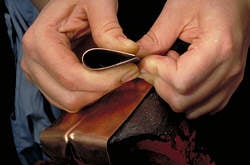Steps on Making a Basic T-fold
This article describes the steps to making a basic T-fold, one of the main categories of fold-forming. Numerous variations are possible from this simple starting place.
1 Minute Read
This page describes the steps to making a basic T-fold, one of the main categories of fold-forming. Numerous variations are possible from this simple starting place.
An example of a T-fold forged with the legs pinned in the vise. On the right is one where the entire table area was thinned with a rounded hammer face, thus arching over the table when annealed and opened
An example of a basic T-fold forged with the legs free. Note how the twisting is modified and affects the table shape upon opening.
Purchase your own copy of “Foldforming (Hardcover)” today. |
You assume all responsibility and risk for the use of the safety resources available on or through this web page. The International Gem Society LLC does not assume any liability for the materials, information and opinions provided on, or available through, this web page. No advice or information provided by this website shall create any warranty. Reliance on such advice, information or the content of this web page is solely at your own risk, including without limitation any safety guidelines, resources or precautions, or any other information related to safety that may be available on or through this web page. The International Gem Society LLC disclaims any liability for injury, death or damages resulting from the use thereof.
Charles Lewton-Brain
Master goldsmith Charles Lewton-Brain trained, studied and worked in Germany, Canada and the United States to learn the skills he uses. Charles Lewton-Brain is one of the original creators of Ganoksin.
The All-In-One Jewelry Making Solution At Your Fingertips
When you join the Ganoksin community, you get the tools you need to take your work to the next level.
Trusted Jewelry Making Information & Techniques
Sign up to receive the latest articles, techniques, and inspirations with our free newsletter.
